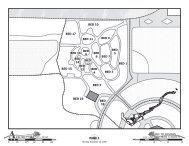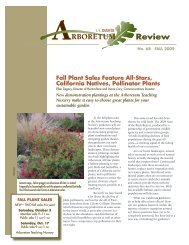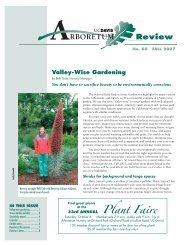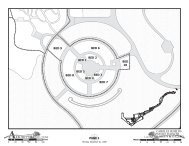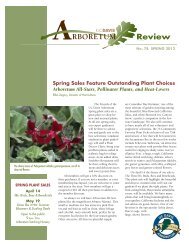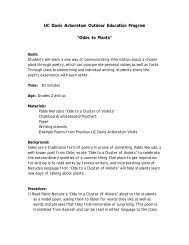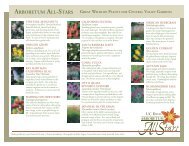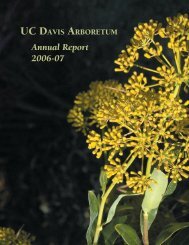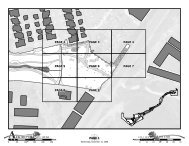Challenges of Central Valley Gardening - the UC Davis Arboretum
Challenges of Central Valley Gardening - the UC Davis Arboretum
Challenges of Central Valley Gardening - the UC Davis Arboretum
You also want an ePaper? Increase the reach of your titles
YUMPU automatically turns print PDFs into web optimized ePapers that Google loves.
Recommended by <strong>UC</strong> <strong>Davis</strong> <strong>Arboretum</strong><br />
<strong>Challenges</strong> <strong>of</strong> <strong>Central</strong> <strong>Valley</strong> <strong>Gardening</strong>:<br />
Creating an All-Star Garden<br />
ELLEN ZAGORY and DIANE CARY<br />
Winter’s low temperatures in California’s<br />
Great <strong>Central</strong> <strong>Valley</strong> rarely fall below<br />
freezing, and, when <strong>the</strong>y do, it is only for brief<br />
periods. (The prolonged freeze <strong>of</strong> winter 2007<br />
was, we hope, an aberration.) We are fortunate<br />
that we can use our gardens, patios, and decks<br />
year-round. Many gardeners create elaborate<br />
outdoor rooms where <strong>the</strong>y socialize, cook, and<br />
pass much <strong>of</strong> <strong>the</strong>ir leisure time. The ability to<br />
spend so much time outside motivates gardeners<br />
to find tough, adaptable plants that have<br />
interest in all <strong>the</strong> seasons. The horticulture staff<br />
at <strong>the</strong> <strong>UC</strong> <strong>Davis</strong> <strong>Arboretum</strong> has selected fifty<br />
<strong>Arboretum</strong> All-Star plants that are reliable,<br />
easy to grow, and will broaden <strong>the</strong> seasons <strong>of</strong><br />
color, fragrance, and beauty in <strong>Central</strong> <strong>Valley</strong><br />
gardens. (See <strong>Arboretum</strong> All-Stars: Great Plants<br />
for <strong>Central</strong> <strong>Valley</strong> Gardens, Pacific Horticulture,<br />
April 2007).<br />
Even without freezing cold, gardeners living<br />
in <strong>the</strong> <strong>Central</strong> <strong>Valley</strong> must deal with some challenging<br />
conditions. Summer temperatures can<br />
soar to over 100° F, <strong>of</strong>ten stressing young transplants.<br />
Intense, hot, north winds in summer<br />
desiccate <strong>the</strong> soil, roots, and young leaves, and<br />
occasionally cause burn on mature trees as<br />
well. Some areas have heavy clay soils that<br />
must be carefully managed, and, as in <strong>the</strong> rest<br />
<strong>of</strong> <strong>the</strong> arid West, <strong>the</strong> quantity and quality <strong>of</strong><br />
irrigation water are significant issues. The<br />
thoughtful selection <strong>of</strong> plants that tolerate <strong>the</strong>se<br />
extremes is <strong>the</strong> keystone <strong>of</strong> a beautiful <strong>Central</strong><br />
<strong>Valley</strong> garden. Successfully growing <strong>the</strong> broadest<br />
spectrum <strong>of</strong> plants is dependent mainly on<br />
four conditions: water quality, soil texture and<br />
drainage, intelligent use <strong>of</strong> shade, and consistent<br />
use <strong>of</strong> thick mulches.<br />
Water quality can vary greatly in different<br />
areas <strong>of</strong> <strong>the</strong> <strong>Valley</strong> depending on <strong>the</strong> source.<br />
Some municipalities use water from rivers that<br />
carry nearly pure mountain run<strong>of</strong>f; o<strong>the</strong>rs<br />
pump from underground aquifers. The quality<br />
<strong>of</strong> aquifer water varies by location, according<br />
to <strong>the</strong> depth from which it is extracted, and<br />
<strong>the</strong> substrate within which it is found. For<br />
example, people in Sacramento can grow azaleas<br />
and dogwoods well because <strong>the</strong>ir water<br />
comes from rivers fed by melting snow and<br />
rain. Communities only ten miles to <strong>the</strong> west,<br />
like <strong>Davis</strong> and Woodland, have little success<br />
with such plants due to minerals in <strong>the</strong> underground<br />
aquifer, probably emanating from<br />
volcanic springs in <strong>the</strong> Vaca Mountains far<strong>the</strong>r<br />
west; <strong>the</strong> presence <strong>of</strong> boron, which is toxic to<br />
<strong>Challenges</strong> <strong>of</strong> <strong>Central</strong> <strong>Valley</strong> <strong>Gardening</strong> / 3
Coral yucca (Hesperaloe parviflora). Photographs by Ellen Zagory, except as noted<br />
many kinds <strong>of</strong> plants, is a particular problem.<br />
O<strong>the</strong>r areas such as Fresno, while on aquifer<br />
water, have fewer problems since <strong>the</strong>y are<br />
closer to <strong>the</strong> Sierra, and <strong>the</strong>ir water supply<br />
arises from more granitic soils. <strong>Valley</strong> gardeners<br />
need to learn about <strong>the</strong>ir irrigation water<br />
and select <strong>the</strong>ir garden plants accordingly.<br />
Soils in <strong>Valley</strong> communities also vary from<br />
easily gardened fine loams to more challenging<br />
heavy clays that require careful grading and<br />
<strong>the</strong> addition <strong>of</strong> gypsum to improve <strong>the</strong>ir structure.<br />
An unseen and <strong>of</strong>ten unrecognized problem,<br />
especially for people with new homes and<br />
landscapes, is <strong>the</strong> presence <strong>of</strong> an agricultural or<br />
construction-caused hardpan a few feet below<br />
<strong>the</strong> soil surface. Contractors <strong>of</strong>ten operate<br />
heavy machinery when soils are moist, compacting<br />
<strong>the</strong>m and causing <strong>the</strong> formation <strong>of</strong> an<br />
impenetrable hardpan layer. If <strong>the</strong> hardpan is<br />
not eliminated by “ripping” (deep plowing), it<br />
can plague <strong>the</strong> gardener for years to come.<br />
Ano<strong>the</strong>r secret to success for <strong>Valley</strong> gardeners<br />
is a landscape design that provides afternoon<br />
shade in summer. Placing one or two<br />
large, deciduous shade trees on <strong>the</strong> west side <strong>of</strong><br />
your property will greatly expand <strong>the</strong> plant<br />
palette that you can grow while enhancing<br />
your own comfort on summer afternoons.<br />
Plants that like full sun on <strong>the</strong> coast <strong>of</strong>ten benefit<br />
from shade in <strong>Valley</strong> gardens; <strong>the</strong>y will look<br />
better and experience less stress if sheltered<br />
from <strong>the</strong> blazing summer heat. In <strong>the</strong> foothills,<br />
gardeners can also take advantage <strong>of</strong> east- and<br />
nor<strong>the</strong>ast-facing slopes for afternoon shade.<br />
Careful placement <strong>of</strong> plants along fences and<br />
under shrubs permits an expanded plant<br />
palette. You may be able to take advantage <strong>of</strong><br />
<strong>the</strong> “borrowed” landscape on <strong>the</strong> o<strong>the</strong>r side <strong>of</strong><br />
<strong>the</strong> fence if your neighbor’s tree extends its<br />
shade in your direction.<br />
4/Pacific Horticulture Jul/Aug/Sep 2007
Wayne Roderick’s seaside daisy (Erigeron glaucus ‘Wayne<br />
Roderick’). Photograph by Saxon Holt<br />
Butterfly rose (Rosa chinensis ‘Mutabilis’) Cenizo (Leucophyllum frutescens)<br />
High light levels due to cloudless summer<br />
skies combine with high air temperatures to<br />
heat bare soils, stressing plants and “cooking”<br />
<strong>the</strong> roots near <strong>the</strong> surface. Intense hot sun can<br />
cause foliar sunburn, especially in low-water<br />
plantings. Using a thick layer <strong>of</strong> mulch to cover<br />
<strong>the</strong> soil keeps <strong>the</strong> root zone shaded and cooler,<br />
in addition to preventing weed germination<br />
and moderating <strong>the</strong> loss <strong>of</strong> soil moisture<br />
through evaporation. Wood chips are heavy<br />
enough to stay put in high winds but coarse<br />
enough to allow irrigation water to penetrate<br />
freely, and <strong>the</strong>y break down slowly when accidentally<br />
mixed with <strong>the</strong> soil below. A four-inch<br />
layer <strong>of</strong> mulch, renewed annually, will moderate<br />
much <strong>of</strong> <strong>the</strong> effect <strong>of</strong> <strong>Central</strong> <strong>Valley</strong> heat and<br />
reduce <strong>the</strong> time spent weeding and watering.<br />
Attention to <strong>the</strong>se four areas—water quality,<br />
soil texture, shade, and mulch —will go a long<br />
way toward meeting <strong>the</strong> challenges <strong>of</strong> garden-<br />
ing in <strong>the</strong> <strong>Central</strong> <strong>Valley</strong>, and will allow <strong>Valley</strong><br />
gardeners to select from a larger plant palette.<br />
Following are a few <strong>of</strong> our favorite plants for<br />
summer color in a hot <strong>Central</strong> <strong>Valley</strong> garden.<br />
<strong>Arboretum</strong> All-Stars for<br />
Summer Bloom in <strong>the</strong> <strong>Central</strong> <strong>Valley</strong><br />
Butterfly rose (Rosa chinensis ‘Mutabilis’) is<br />
a big shrub with large, multi-colored, singlepetaled<br />
flowers nearly year-round, complemented<br />
by burgundy-colored new stems. With<br />
weekly or bi-weekly irrigation, it rewards us<br />
with a March to October flowering season.<br />
Grow this deciduous shrub in full sun.<br />
Remove old stems to <strong>the</strong> ground in winter<br />
to keep it compact; it can be kept at four to<br />
five feet tall with annual pruning.<br />
Cenizo (Leucophyllum frutescens), also known<br />
<strong>Challenges</strong> <strong>of</strong> <strong>Central</strong> <strong>Valley</strong> <strong>Gardening</strong> / 5
as Texas ranger, is a reliable heat- and droughttolerant<br />
evergreen shrub to six or seven feet<br />
tall. It requires little pruning but can be hedged<br />
and shaped if desired. The striking silvery<br />
foliage provides a marvelous backdrop in<br />
<strong>the</strong> heat <strong>of</strong> summer, when <strong>the</strong> plants are<br />
covered with lavender pink flowers. Cenizo<br />
glories in <strong>the</strong> heat and is excellent for<br />
low-water landscapes.<br />
Coral yucca (Hesperaloe parviflora) is a spiky<br />
accent plant, two to three feet tall and three to<br />
four feet wide, that adds a strong architectural<br />
note to any garden. It thrives in full sun and is<br />
dependably drought tolerant—perfect for<br />
water-conserving landscapes with minimum<br />
maintenance. In summer, it produces long<br />
spikes <strong>of</strong> waxy, coral pink flowers. The flowers<br />
are long lasting in floral arrangements and<br />
highly attractive to hummingbirds, which add<br />
<strong>the</strong>ir own sparkle when <strong>the</strong>y visit <strong>the</strong> garden.<br />
Wayne Roderick’s seaside daisy (Erigeron<br />
glaucus ‘Wayne Roderick’) grows in sun or<br />
Advice to Those About to Move<br />
Don’t, until you’ve told us your new<br />
address.<br />
The Post Office does not automatically<br />
forward Pacific Horticulture to your new<br />
address. Instead, <strong>the</strong> undelivered copy is<br />
destroyed and, if known, your new address<br />
is sent to us with <strong>the</strong> label section from<br />
<strong>the</strong> back cover <strong>of</strong> <strong>the</strong> lost copy. We are<br />
charged 70¢ for each returned back cover at<br />
<strong>the</strong> Post Office.<br />
Added to <strong>the</strong> cost <strong>of</strong> replacement and<br />
remailing this is a burden for our hand-tomouth<br />
not-for-pr<strong>of</strong>it foundation. A simple<br />
post card in good time avoids <strong>the</strong> loss and<br />
<strong>the</strong> cost.<br />
Please send your address change, including<br />
phone number, to <strong>the</strong> Circulation Department,<br />
Pacific Horticulture, PO Box 680,<br />
Berkeley, CA 94701.<br />
partial shade with deep watering only every<br />
two weeks. A California native perennial that<br />
prefers afternoon shade in <strong>the</strong> <strong>Central</strong> <strong>Valley</strong>, it<br />
blooms from March to October with attractive<br />
lavender daisy flowers. It also attracts beneficial<br />
insects like syrphid flies that help control aphids<br />
(see Pacific Horticulture, April ’07, pp 14-15).<br />
If You Should Like to Visit . . .<br />
The <strong>UC</strong> <strong>Davis</strong> <strong>Arboretum</strong> is located on <strong>the</strong><br />
<strong>Davis</strong> campus, stretching two miles along <strong>the</strong><br />
banks <strong>of</strong> <strong>the</strong> old north fork <strong>of</strong> Putah Creek,<br />
with headquarters on LaRue Road. The annual<br />
fall plant sale will be on Saturday, October 6 at<br />
<strong>the</strong> <strong>Arboretum</strong> Nursery at Orchard Park. For<br />
more information about <strong>the</strong> <strong>UC</strong> <strong>Davis</strong><br />
<strong>Arboretum</strong>, <strong>the</strong> <strong>Arboretum</strong> All-Stars program,<br />
membership in <strong>the</strong> Associates, volunteer<br />
opportunities, or directions and a map, please<br />
call 530/752-4880 or visit arboretum.ucdavis.edu.<br />
A Pacific Horticulture Symposium<br />
<strong>Gardening</strong> Under<br />
Mediterranean Skies V:<br />
Lessons In Our Gardens —<br />
San Diego<br />
Quail Botanical Gardens<br />
September 29-30, 2007<br />
Enjoy two days <strong>of</strong> garden tours and talks<br />
in some <strong>of</strong> San Diego’s finest gardens. Learn<br />
to create gardens that work with your climate<br />
so you can have a beautiful landscape with a<br />
lower water bill and less maintenance. Visit a<br />
garden designed for birds, butterflies and<br />
year-round flowers. Spend time in a worldclass<br />
garden <strong>of</strong> succulents, and learn how to<br />
create a garden <strong>of</strong> colorful native plants, plus<br />
much more! Plus a free day <strong>of</strong> programs at<br />
The Water Conservation Garden at Cuyamaca<br />
College. Registration form opposite page 56.<br />
For more information, visit<br />
skies@sdhortsoc.org<br />
6/Pacific Horticulture Jul/Aug/Sep 2007



